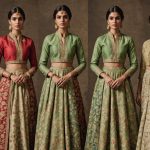The Evolution of UK Women’s Fashion Aesthetics: A Historical Journey to UK Women’s Fashion History
The history of women’s fashion in the UK is a rich and diverse tapestry, woven from various cultural, social, and artistic influences. From the opulent gowns of the Victorian era to the modern, avant-garde designs of today, British fashion has been shaped by a multitude of factors. This article will delve into the key historical influences that have defined the aesthetic of women’s fashion in the UK.
The Victorian Era: A Time of Opulence and Restriction
The Victorian era, spanning from the late 1830s to the early 1900s, was marked by a strict social hierarchy and rigid moral codes. Women’s fashion during this period reflected these societal norms, with an emphasis on modesty and restraint.
In parallel : How Can UK Women Style Traditional Outfits with a Modern Twist?
The Aesthetic Movement and Its Impact
The Aesthetic Movement, led by figures such as Oscar Wilde and William Morris, sought to challenge the conventional norms of beauty and art. This movement advocated for the importance of beauty for its own sake, rather than for moral or utilitarian purposes. In fashion, this translated into a focus on natural fabrics, simpler silhouettes, and an emphasis on artistic detail.
Key Features of Victorian Fashion:
This might interest you : What Are the Best Tips for Layering Clothes in the UK Climate?
- Corsets and Bustles: Women wore tightly laced corsets and bustles to achieve the desired hourglass figure.
- Layered Clothing: Multiple layers of petticoats, underskirts, and over-skirts were common.
- Fabrics: Rich fabrics like silk, velvet, and lace were favored.
- Accessories: Hats, gloves, and parasols were essential accessories.
The Influence of the Pre-Raphaelite Brotherhood
The Pre-Raphaelite Brotherhood, a group of artists including Dante Gabriel Rossetti and John Everett Millais, also had a significant impact on fashion. Their emphasis on medieval and Renaissance themes led to a revival of interest in historical and mythological subjects. In fashion, this manifested in the use of rich colors, intricate patterns, and a focus on handcrafted details.
Quote from Oscar Wilde:
“To live is the rarest thing in the world. Most people exist, that is all.”
The Early 20th Century: The Rise of Modernity
As the 20th century dawned, women’s fashion began to undergo a radical transformation. The restrictive garments of the Victorian era gave way to more liberated and modern designs.
The Gibson Girl and the New Woman
The Gibson Girl, a creation of American illustrator Charles Dana Gibson, represented the ideal of the “New Woman” – independent, educated, and active. This figure influenced British fashion, with women adopting more practical and less restrictive clothing.
Characteristics of Early 20th Century Fashion:
- Simplification of Silhouettes: Dresses became less layered and more streamlined.
- Rise of the Hemline: Skirt lengths began to rise, reflecting the increasing freedom of women.
- Sportswear Influence: Clothing inspired by sports, such as tennis and golf, became more mainstream.
The Mid-20th Century: Post-War Revolution
Following World War II, British fashion experienced a significant revolution, driven by economic necessity and cultural change.
The Impact of Rationing and Utility Clothing
During World War II, clothing rationing was introduced in the UK. This led to the development of utility clothing, characterized by simplicity, practicality, and the use of minimal fabric. Designers like Norman Norell and Hardy Amies created garments that were both stylish and economical.
Key Features of Post-War Fashion:
- Austerity Chic: Simple, functional designs became fashionable.
- Influence of American Culture: American fashion, particularly the “Ivy League Look,” gained popularity in the UK.
- Emergence of Youth Culture: The rise of youth culture, including the Teddy Boys and Mod subcultures, influenced fashion with bold, youthful styles.
The Late 20th Century: Punk and New Wave
The late 1970s and early 1980s saw the emergence of punk and new wave movements, which drastically altered the fashion landscape.
Punk Fashion: Rebellion and Anti-Fashion
Punk fashion, led by figures like Vivienne Westwood and Malcolm McLaren, was a direct rebellion against mainstream culture. Characterized by ripped clothes, safety pins, and bold graphics, punk fashion challenged traditional notions of beauty and elegance.
Punk Fashion Elements:
- Ripped and Torn Clothing: Deliberate damage to garments was a statement against consumerism.
- Safety Pins and Studs: Used as both functional and decorative elements.
- Bold Graphics and Logos: Anti-establishment slogans and logos were common.
New Wave and the Rise of London as a Fashion Capital
The new wave movement, which followed punk, brought a more polished and avant-garde approach to fashion. Designers like Alexander McQueen and John Galliano helped establish London as a major fashion capital.
New Wave Fashion Characteristics:
- Avant-Garde Designs: Experimental and innovative designs became popular.
- Influence of Art and Music: Fashion was heavily influenced by art, music, and other cultural movements.
- Global Recognition: London Fashion Week gained international recognition.
Contemporary UK Women’s Fashion
Today, UK women’s fashion is a vibrant and diverse field, influenced by a wide range of global and local factors.
The Role of Museums and Art in Fashion
Museums like the Victoria and Albert Museum in London and the Metropolitan Museum in New York play a crucial role in preserving and showcasing fashion history. Exhibitions and collections inspire contemporary designers and provide a rich historical context for modern fashion.
Quote from Andrew Bolton, Curator at the Metropolitan Museum:
“Fashion is not just about clothes; it’s about culture, it’s about society, it’s about politics.”
Sustainable Fashion and the Future
In recent years, there has been a growing emphasis on sustainable fashion. Designers are increasingly focusing on ethical production methods, sustainable materials, and reducing waste.
Sustainable Fashion Practices:
- Use of Eco-Friendly Materials: Fabrics made from recycled materials or organic sources.
- Slow Fashion: Encouraging consumers to buy fewer, higher-quality garments.
- Circular Economy: Designing garments that can be recycled or reused.
Practical Insights and Actionable Advice
For those interested in exploring the historical influences on UK women’s fashion, here are some practical insights and actionable advice:
Visiting Fashion Museums
- Victoria and Albert Museum, London: One of the world’s largest and most comprehensive fashion collections.
- Metropolitan Museum, New York: The Costume Institute at the Met is renowned for its fashion exhibitions.
Reading Fashion History
- “The Fashion Book” by Phaidon: A comprehensive guide to fashion history.
- “The Aesthetic Movement in England” by Walter Hamilton: A detailed look at the Aesthetic Movement.
Incorporating Historical Elements into Modern Wardrobes
- Layering: Use layers to create a versatile and stylish outfit, inspired by Victorian fashion.
- Natural Fabrics: Opt for natural fabrics like silk and cotton, which were favored during the Aesthetic Movement.
- Bold Accessories: Add bold, artistic accessories, such as hats and gloves, to give your outfit a touch of historical flair.
The history of UK women’s fashion is a complex and fascinating narrative, influenced by a myriad of artistic, social, and cultural factors. From the opulent gowns of the Victorian era to the avant-garde designs of today, each period has contributed uniquely to the aesthetic of British fashion. By understanding and appreciating these historical influences, we can better navigate the ever-evolving landscape of fashion and make informed choices about our own style.
Detailed Table: Historical Influences on UK Women’s Fashion
| Era | Key Influences | Fashion Characteristics | Notable Figures |
|---|---|---|---|
| Victorian Era (1837-1901) | Aesthetic Movement, Pre-Raphaelite Brotherhood | Corsets, bustles, layered clothing, rich fabrics | Oscar Wilde, William Morris, Dante Gabriel Rossetti |
| Early 20th Century (1901-1945) | Gibson Girl, New Woman | Simplified silhouettes, rising hemlines, sportswear influence | Charles Dana Gibson |
| Post-War Era (1945-1970) | Rationing, Utility Clothing, American Culture | Austerity chic, functional designs, youth culture | Norman Norell, Hardy Amies |
| Punk and New Wave (1970s-1980s) | Punk Rebellion, New Wave Avant-Garde | Ripped clothing, safety pins, bold graphics | Vivienne Westwood, Malcolm McLaren, Alexander McQueen |
| Contemporary Era (1990s-Present) | Sustainable Fashion, Global Influences | Eco-friendly materials, slow fashion, circular economy | Andrew Bolton, Stella McCartney |
Detailed Bullet Point List: Visiting Fashion Museums
-
Victoria and Albert Museum, London:
-
Home to one of the world’s largest and most comprehensive fashion collections.
-
Features exhibitions on historical and contemporary fashion.
-
The National Art Library within the museum offers extensive resources on fashion history.
-
Metropolitan Museum, New York:
-
The Costume Institute is renowned for its fashion exhibitions.
-
Annual Met Gala showcases the latest in fashion and culture.
-
The museum’s collection includes garments from the 18th century to the present day.
-
Museum of London:
-
Exhibitions on London’s fashion history, including the impact of punk and new wave.
-
Collections on historical dress and accessories.
-
Regular events and workshops on fashion and textiles.
By exploring these museums and understanding the historical context of UK women’s fashion, you can gain a deeper appreciation for the evolution of style and aesthetics over the centuries.






